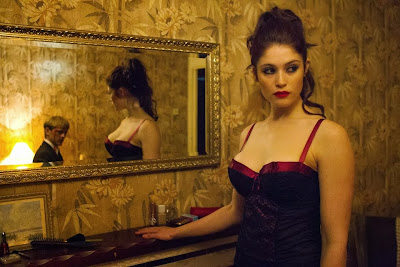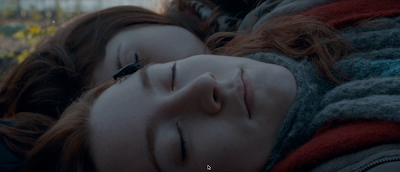For a filmmaker who isn't normally thought of as a genre director, Neil Jordan sure does make a lot of horror movies. Byzantium (2013) is his second vampire film, and acts as a kind of distaff companion piece to Interview With the Vampire. Jordan is attracted to the Gothic roots of the horror film, which are on full display in Byzantium, a film that nests flashbacks inside flashbacks, and spirals around its narrative to come at its core elements obliquely. Those core elements are the two great themes of the Gothic: sex and death.
Byzantium follows Eleanor and Clara, two vampires in contemporary Britain. Eleanor is Clara's daughter, turned into a vampire when she was sixteen and burdened with a deep melancholy. She obsessively writes her story only to scatter the pages to the winds. She feeds, but she only takes the willing, usually those at the edge of death already. Clara is not so discerning. Clara provides for the two as a sex worker, which gives her a broad hunting ground of predatory men. Clara was coerced into harlotry in her youth by the nefarious Captain Ruthven, who defiled her and consigned her to a brothel. While there, she gave birth to Eleanor and placed her in an orphanage, providing her upkeep on her knees and on her back until consumption caught up with her. Ruthven's rival, Darvell, was thought dead in Ireland, but returned to confront Ruthven's perfidy with the gift of unlife. This tale comes out as Eleanor unwillingly falls for the sickly Frank, a kind waiter at a seaside restaurant. Frank is smitten with her after hearing her play a mournful song on the restaurant's piano. She gives him the story of her life even as the brotherhood of vampires closes in on her and her mother. Female vampires are forbidden by the Brotherhood, and given that Clara stole the gift intended for Ruthven, she's on a short leash. In making Eleanor a vampire, she has violated their rules, and they live under a death sentence if ever they are found...
The title of the film, "Byzantium," refers to a dissolute hotel at the resort town where Clara and Eleanor have gone to ground. It's owned by a man who Clara targeted as a victim, but relented when a better option presented itself. The hotel acts as a metaphor for the world that our two lead characters inhabit: well past its time, a relic of better days. Jordan shoots the interior of the Byzantium with a feel for decadent opulence that escapes him in the multiple flashback scenes to the Regency era. Those scenes have a Hammer Horror feel to them that the film underlines by quoting Dracula: Prince of Darkness on screen. The contrast with the tired resort town where the film is set is striking. Jordan also indulges in the mythological visions of The Company of Wolves in his flashbacks when he depicts the Lovecraftian temple where his characters meet their unlife, accompanied by torrents of blood. These scenes are full-dress Gothic, complete with the confined monstrous feminine and the idea of the doppelganger as dark mirror. It's an attractive movie, one that often encompasses the ornate Gothic with a more modern kitchen-sink drabness inside the same frame. This was shot on an Arri Alexa, and it's demonstrative of the increasing dynamic range of digital, something of which cinematographer Sean Bobbitt takes full advantage.
This is ultimately a character piece. Oh, the instruments of genre are deployed, make no mistake. This is a sanguinary horror film that spills copious amounts of blood. The film is barely fifteen minutes in before there's a scene of shocking violence. The movie isn't about these scenes, though. It's primarily about melancholy, about filial love, about mothers and daughters, and about the brutality of patriarchy. If it's not obvious from the outline of its plot that this is an overtly feminist film, then the film puts an exclamation point on things in its endgame. But, as I say, this is a character piece, and a showcase for its lead actresses. Saoirse Ronan's Eleanor could come off as just another mopey teenager, but for the deep emotions on the actress's face. Ronan has one of those faces that expresses deep emotions without histrionics and Ronan is one of the premiere actresses of her generation. She's internalized the fact that all you need to do is think it and the camera will see it. The camera loves her face not in the way it loves glamour, but rather in the way it loves thought and expression. Jordan surrenders to this, and composes artful close-ups for her throughout.
Gemma Arterton's Clara, by contrast, is rarely filmed in close-up, in part because the (male) gaze of the film wants to take in the spectacle of the actress's body (and, believe me, it's spectacular), but also because she's more inherently alien than Eleanor. She's a rapacious, sexual being and she communicates that with body language rather than expression. She's less introspective than Eleanor, less ethereal, and more violent. The film codes this during its contemporary scenes by dressing Arterton in a animal prints and leather.
The male characters fare less well. Johnny Lee Miller's Ruthven is a villain out of a melodrama (possibly justifiable, given the source of his character's name). Darvell isn't on screen enough to justify the turn of the plot at the end of the film, though his first scenes try. Daniel Mays's character, Noel, is the owner of the Byzantium, and he gets a big emotional scene early in the film that doesn't seem organic to the film. In truth, he seems like a necessary plot device rather than a character. Only Caleb Landry Jones really inhabits his character and makes him live and breathe. Jones plays his illness well (as he did in Antiviral, as well; dude needs to get some sun), and his conflicted feelings for Eleanor are entirely believable.
If I have a qualm with the movie, it's the ambivalence it shows for Clara. At points, Clara is a victim. At others, she's a feminist avenger. At still others, she's defending her right to even exist to a cabal of patriarchal capos. And toward the end, the film begins to paint her as a villain, before turning away from this thread in a deus ex machina turn of the tale. Arterton is up to any of these roles, should the film require them, so it's frustrating that it doesn't really know what to do with her character. The end of the film is its Achilles heel.
That all said, this might be my favorite of Jordan's horror films. It's certainly a more palatable Gothic than his other vampire film, even as it reworks elements from it. Certainly, Eleanor is a more thoughtful re-imagining of Interview's Claudia, and on the whole Byzantium has a firmer grasp of the loneliness immortality entails. It lacks the gonzo freakout of The Company of Wolves, but it substitutes more nuanced control of its material. More than that, though, this is a film that has a handle on the uses of the Gothic even in modern dress, and finds in them a still-powerful crucible in which to test his themes and characters.
Current Challenge tally:
Total Viewings: 23
First Time Viewings: 19
Around the Web:
Fascination with Fear offers up a look at kinky sex in horror movies. I approve, of course.
Behind the Couch dives back into Lovecraft with a look at The Call of Cthulhu.
Kevin at For it Is Man's Number takes a short vacation to Silent Hill.
























No comments:
Post a Comment